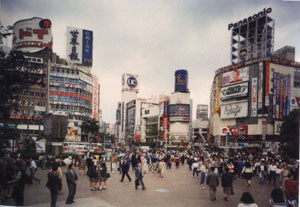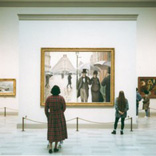Thomas Struth 1977-2002, currently on view at the Dallas Museum of Art, reveals the photographer’s astute ability to capture the temperament and interconnectedness of his subjects’ documentary elements. His bodies of work underscore the overarching relationships between human beings, our natural world, and the world we have constructed. This retrospective includes a myriad of subject matter: flowers, still-lifes, stark city skyscrapers, museums, crowded avenues, and family life are all featured; so viewers moved by nature, architecture, cultural studies or portraiture can be satisfied.
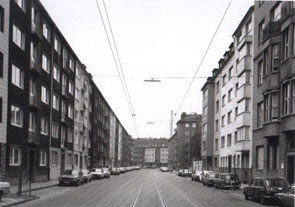
Thomas Struth, Sommerstrasse, Düsseldorf, Düsseldorf, 1979 ...Gelatin silver print, 16½" x 22" ...Dallas Museum of Art, gift of Robert M. Levy
Struth’s work is arranged throughout the Chilton galleries by grouping, so that the viewer may consider how each body of work reveals his various levels of environmental awareness. The fresh green shelter of leafy canopies and the black and white prints of deserted urban landscapes both suggest the solitude of the individual, perhaps engulfed in the sublime — in one case sublimity of nature, in the other sublimity of bleak constructed landscapes. In contrast, Struth’s museum portraits and photographs of Asian street life represent both acknowledged and unacknowledged members of specific communities, and explore how humans interact within society. Individuals photographed with their families pare this down to a more intimate, individual level, returning to the nature and empty city photographs which are devoid of humans.
Included to underscore their precedence, the early black and white uninhabited street scenes are the foundation of Struth’s bodies of work. In these prints, the eye is drawn to an obvious focal point, lead by street angles, winding sidewalks, small city trees, or parked cars. Struth calls this focus of the city photographs the “crystallization point,” and out of these visual, architectural and social points stem and grow all the cultural phenomena documented in his later work. This early aesthetic is echoed in a few full-color examples of his later work: a frenzied melange of commerce and customer in Shibuya Crossing, Tokyo, a fantasy green “Treasure Island” lagoon in Las Vegas1, and Dallas Parking Lot, Dallas, 2001. Although examples one and two probably have more universal appeal, example three reminds those native to the region to consider the beauty of their own surroundings. This is where Struth offers a new view to those familiar with the locale; he captures a silvery light from the novel vantage point of downtown Dallas as seen from the roof of a mid-rise parking lot. Not as a tourist who is seeing the view for the first time, but as a sort of indifferent lobbyist, he captures something ineffable in a seemingly unremarkable landscape.
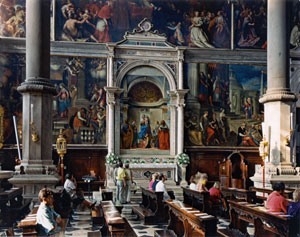
Thomas Struth, Art Institute of Chicago II, Chicago, 1990 ...C-print, 54" x 68 ¾"...©2002 Thomas Struth, courtesy of Marian Goodman Gallery
Struth is perhaps best well known for his museum portraits, and there is a reason for this. A mildly odd phenomenon occurs as you stand in the Dallas Museum of Art before an image of other people standing before images in the National Gallery in London. You become more aware of the spectators around you sharing the same experience in your own plane of existence. Like in a movie or a novel, there is something unreal or fictional-seeming about those other people in that other museum Struth has documented.
In his photographs of the public interacting with historical buildings of interest, the extended exposure time reveals most subjects in subtle, blurry transition. In San Zaccaria, the entire scene is steeped in somber meditation as most visitors inside the baroque church quietly contemplate. As one small girl in yellow throws her head back to look at the vast ceiling, the other participants in the scene seem to sway back and forth before your eyes.
Zeroing in on the next smallest level of human society, Struth’s portraits of grandfathers, students, businessmen, doctors, art dealers and mothers are all pared down to the simplest and most obvious characteristics. The texture and tonality of skin, hair, symmetry and asymmetry are all intensely magnified, again in Struth’s large format. His portraits give the illusion that if one could look close enough and long enough at the individuals, the veins and all that lies underneath their skin might become visible. The minutest details of the outward appearance of each subject are cause for scrutiny. Though each subject is different, up close a pore is a pore is a pore, and the sameness off all the flesh and blood is accentuated.
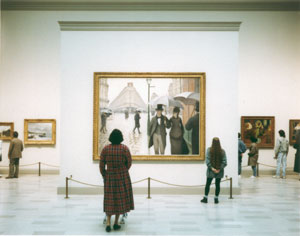
Thomas Struth, San Zaccaria, Venice, 1995 ...C-print, 70¾" x 90"...©2002 Thomas Struth, courtesy of Marian Goodman Gallery
The monumental size of most of Struth’s prints is enough to draw you in closer to each work. It’s hard to resist the desire to peer around the sides of the plexiglass-mounted photographs to try and make visual sense of it all. As if each photograph is internally lit, the atmosphere and aura of Struth’s photographs are his signature, vibrant style.
Within the few rooms of photographs, one is confronted with images of every relational environment that we might experience as human beings: solitude (both in city life and nature), family life, and community. The success of the bodies of work in this retrospective lies in the dialogue that they generate between one another, the viewer and the museum environment. This exhibition begs us to find another photographer whose work is so simple yet challenging. Ultimately, in this exhibition Struth beckons for us to consider the beauty present in our everyday surroundings, and to consider how uniqueness and connection to a larger whole are not mutually exclusive.
Melissa Mudry lives in Houston, Texas.


